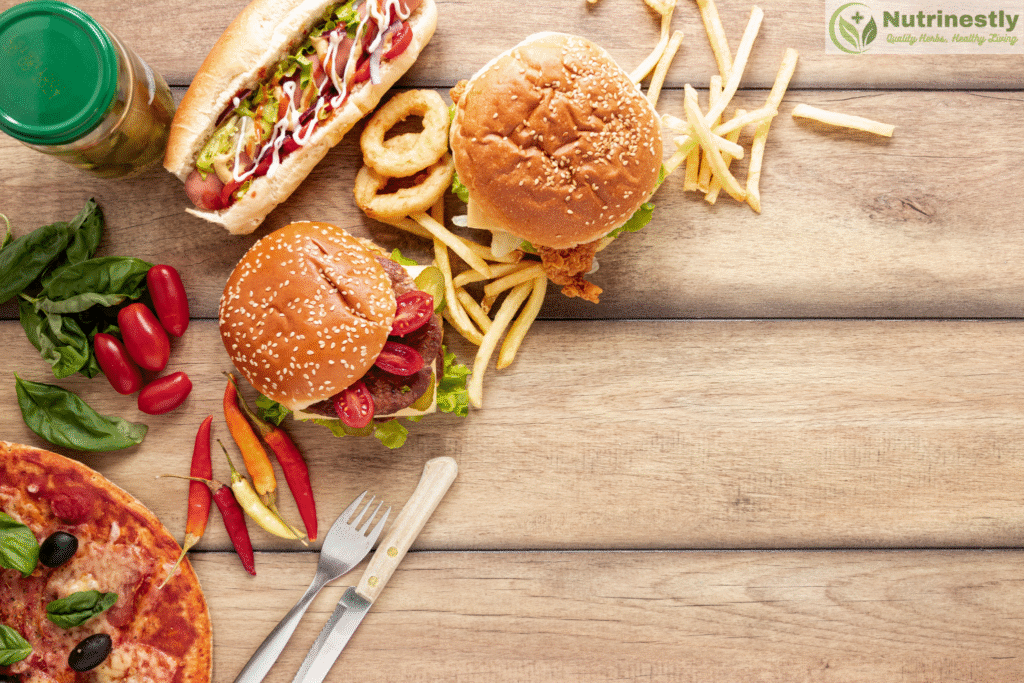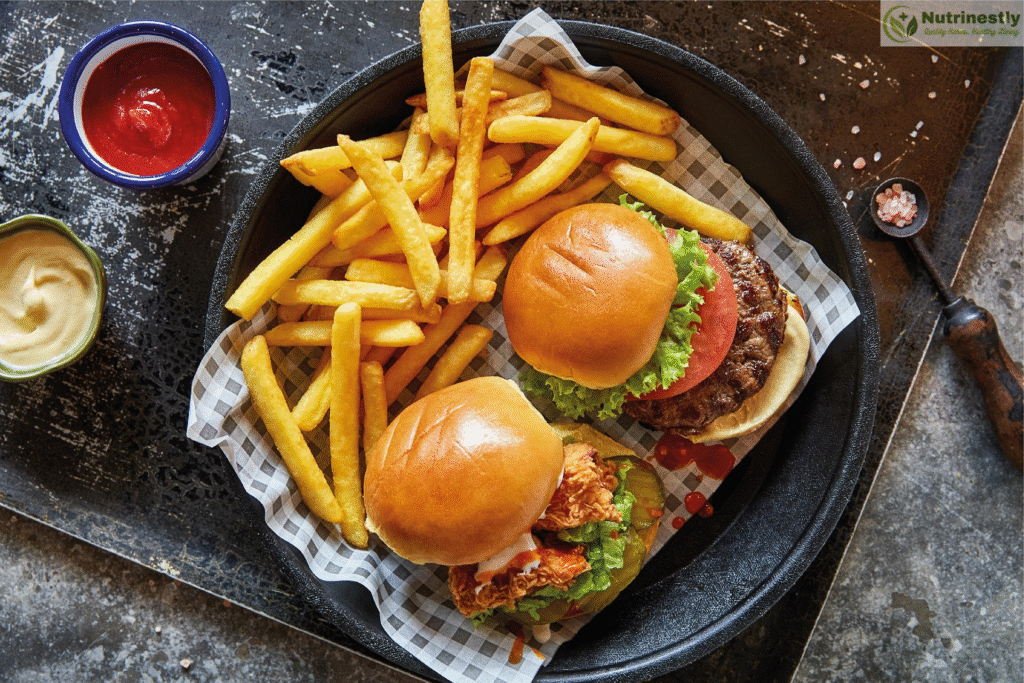
Are You Eating Too Much Sodium Without Realizing It?
Why Your Focus Should Be on Sodium: Sodium is one of those sneakily majestic elements that has extremely important roles in the body but can be extremely dangerous when abused. For example, sodium helps control the balance of fluids in the body, aids in nerve functioning, and even in moving muscles. But here’s the problem: sodium is ubiquitous with the level of convenience meals like fast food offers. In most cases, it’s present in quantities that are much higher than is necessary.
This blog aims to explain the bottom-line logic that allows one to balance the two conflicting sides of the sodium sword. This post will discuss what fast food means, what too much sodium in the body implies, and above all, how it’s possible to have fast foods while still restricting sodium intake.
Understanding Sodium and Its Impact on Health.
The American Heart Association suggests a daily sodium intake limit of 2,300 milligrams, although sodium is necessary in certain quantities closer to 1,500 mg.
Regrettably, the typical American ingests more than 3,400 mg of sodium every day over two times more than is advised. This excessive intake is inextricably linked to grave diseases such as high blood pressure, cardiovascular illness, kidney disorders, and stroke. Too much sodium also brings on water retention, which creates uneasy bloating and a sensation of heaviness.
The issue isn’t so much the salt shaker on the home table most of the sodium we ingest is from restaurant fare and processed foods, particularly fast food.
Why Fast Food Is a Major Source of Sodium
Fast food is designed to be delicious, uniform, and shelf-stable. Sodium has a large role to play in this. Sodium adds flavor, preserves ingredients, and gives processed foods such as breads, meats, and sauces better texture. Even foods you would least expect soups, breads, and so-called “healthy” grilled chicken have high levels of sodium from marinades, pre-cooking steps, or preservatives.
Consider this: a single fast food burger or chicken sandwich can contain anywhere from 1,000 to 1,700 mg of sodium. That’s more than half (and sometimes the entirety) of your recommended daily limit in one item. Add fries, a dipping sauce, or a soda, and you’re easily well over the edge.
To make things even more complicated, even so-called “healthier alternatives” such as wraps, salads, or veggie bowls may be sodium-laden if you’re not being mindful of ingredients such as cheese, dressings, or processed toppings.
Smart Choices at Fast Food Places
So how do you indulge in fast food without exceeding your sodium budget? The trick is to make conscious, informed choices. Here’s how to do that without making the experience a stressful one.
1. Do a Little Research Beforehand
Most major fast food chains now provide full nutritional information on their websites or mobile apps. Before placing your order, take a moment to review the sodium content of your go-to items. Even a quick scan can reveal surprising facts like how a simple grilled chicken wrap might have more sodium than a small burger.
Understanding what’s coming helps you make a good decision in the moment, particularly when you’re hungry and prone to reaching for the familiar.
2. Customize Your Order
One of the best ways to cut sodium is to request basic customizations. Most fast-food chains are quite accommodating when it comes to tweaking your order.
You can request no cheese, omit the bacon, hold off on or eliminate sauces, and opt for grilled alternatives rather than fried. Most sandwiches can be had without the bun or on a lettuce wrap, reducing not only carbs but also sodium from baked bread items as well.
Even minor modifications, such as requesting sauce on the side, can allow you to have control over how much sodium you’re really consuming.
3. Opt for Less Complex Items
The more complicated something is layered sandwiches, stuffed burritos, or combination bowls the more sodium it will generally have. Plain choices such as an uncheesed burger, a simple grilled chicken sandwich, or a vegetable side can be surprisingly filling and much kinder to your sodium budget.
For instance, a plain McDonald’s hamburger contains approximately 470 mg of sodium, while a Big Mac contains 1,050 mg. A grilled chicken sandwich with no sauce or cheese may reduce your consumption by 500–800 mg over the original menu item.
Examples of Low-Sodium Choices at Major Chains

Menus and nutrition facts may fluctuate, but here are some general examples of improved choices at major fast food chains:
McDonald’s
| Menu Item | Approximate Sodium Content |
|---|
| Fruit & Maple Oatmeal | 150 mg |
| Plain Hamburger | 470 mg |
| Side Salad (no dressing) | Virtually 0 mg |
| Apple Slices | 0 mg |
Chick-fil-A
| Item | Sodium (mg) |
|---|---|
| Grilled Nuggets (8-count) | 440 mg |
| Kale Crunch Side | 140 mg |
| Fruit Cup | 0 mg |
Taco Bell
| Item | Sodium (mg) |
|---|
| Crunchy Taco | 170 mg |
| Veggie Power Bowl (custom, no sauces) | 500–600 mg |
| Black Beans | 140 mg |
Subway
| Item | Sodium (mg) |
|---|---|
| 6″ Veggie Delight on Wheat (no cheese) | ~370 mg |
| Mini Turkey Sub (with minimal condiments) | ~500–550 mg |
Starbucks
| Item | Sodium (mg) |
|---|---|
| Hearty Blueberry Oatmeal | 125 mg |
| Egg White & Red Pepper Sous Vide Bites | ~470 mg |
Whenever possible, complement these foods with unsweetened tea, black coffee, or plain water instead of sodium-filled beverages or sugar-sweetened beverages.
Long-Term Low Sodium Eating Tips for On-The-Go
Remaining low sodium but still indulging in convenience requires practice, but it’s not impossible by any means. Here are a few more tips to make it a habit:
Start Small: Don’t attempt to change everything at once. Start by cutting cheese or omitting a sauce
- Track Your Intake: Utilize an app such as MyFitnessPal or Nutritionix to keep track of sodium during the day, particularly if you dine out more than once.
- Limit One Sodium-Rich Meal per Day: If lunch is rich, keep breakfast and dinner less sodium-rich.
- Drink More Water: Sodium causes the body to hold water. Drinking water can help flush out excess and leave you feeling level.
- Prepare Easy Snacks: Pack low-sodium snacks such as fruit, raw nuts (unsalted), or whole-grain crackers to suppress hunger and cut down on fast food.
Conclusion:
Balance Convenience with Health
Fast food doesn’t have to sidetrack your health objectives, particularly when it comes to sodium. With some advance planning, a few savvy substitutions, and a willingness to ask for what you want, you can appreciate the convenience of a quick meal without costing your body.
The solution is knowledge. By understanding where sodium likes to hide and how much sodium you’re actually ingesting, you can begin to make healthier decisions that aid your long-term health without sacrificing the freedom and quickness you need to keep up in everyday life.
Next time you’re looking at a drive-thru menu, take heart: you’re not a victim. You’re empowered. And armed with that power, you can eat better every lower-sodium bite you take.
Frequently Asked Questions (FAQ)
1. What is considered a low sodium meal at a fast food restaurant?
A meal with 600 mg of sodium or less is generally considered low-sodium in the fast food world. Keep in mind, daily sodium intake should be under 2,300 mg and ideally closer to 1,500 mg if you’re watching your blood pressure or heart health. If your meal keeps you well below that, you’re on the right track.
2. Can I eat fast food regularly and still maintain a low sodium diet?
Yes, but you’ll need to be selective and intentional. Focus on simpler items, customize your orders, and balance sodium-heavy meals with low-sodium choices throughout the rest of your day. Also, using apps or nutrition calculators can help you stay on track without obsessing over every bite.
3. Which fast food restaurant has the lowest sodium options overall?
Chains like Chick-fil-A, Subway, and Starbucks offer several customizable or naturally low-sodium items. However, no one chain is perfect; it’s more about knowing which specific items are better and adjusting them to suit your needs.
4. Are “healthy” fast food options always low in sodium?
Not always! Many so-called “healthy” items like salads, grilled chicken sandwiches, or wraps—can be loaded with sodium due to dressings, marinades, cheeses, and sauces. Always check nutrition facts and ask for customizations like “sauce on the side” or “no cheese” to keep sodium in check.
5. How can I reduce sodium in my fast food order?
Here are a few easy tips:
- Skip the cheese, bacon, and salty sauces
- Go for grilled instead of fried
- Order sauces and dressings on the side
- Request no added salt when possible
- Choose simple sides like fruit or side salads
Even cutting back in just one area can save you hundreds of milligrams of sodium.
6. Is it better to skip the combo meal?
Usually, yes. Combo meals often include high-sodium sides and drinks (like fries and soda). Ordering items à la carte lets you control portions, choose better sides (like a fruit cup or salad), and avoid the extra sodium that comes with bundled meals.
7. What are some examples of low-sodium fast food breakfast options?
Here are a few good picks:
- Starbucks Hearty Blueberry Oatmeal (125 mg)
- McDonald’s Fruit & Maple Oatmeal (150 mg)
- Egg White Bites (Starbucks) – ~470 mg
- Plain coffee + fruit or yogurt from most cafés or quick stops
Breakfast is a great opportunity to start the day with something light and low in sodium.
8. Does sodium in fast food affect everyone the same way?
Not exactly. Some people are more salt-sensitive, especially those with high blood pressure, kidney issues, or certain heart conditions. Even if you don’t feel the effects immediately, long-term high sodium intake can still increase your health risks over time.
9. Are there any fast food chains with low sodium kids’ meals?
Yes! Look for kids’ meals with:
- Grilled chicken options
- Milk or water instead of soda
- Fruit or applesauce instead of fries
Chick-fil-A and McDonald’s both offer lower sodium kids’ meal choices just skip the cheese and opt for smaller portions.
10. Where can I find accurate sodium info for fast food items?
Most fast food chains provide full nutrition facts on their:
- Official websites
- Mobile apps
- In-store brochures or posters
You can also use third-party nutrition tracking apps like:
- MyFitnessPal
- Nutritionix
- Lose It!
These tools are great for planning ahead or quickly checking sodium levels on the go.

